Holmes Institute - Finance for Business - Masters Group Report
VerifiedAdded on 2022/09/09
|21
|4455
|19
Report
AI Summary
This report, prepared for a Finance for Business course at Holmes Institute, analyzes the financial market, focusing on securities in the Australian financial market, and risk analysis. The report begins by comparing common stocks, bonds, and preferred stocks from an investor's perspective, followed by an analysis of the five basic principles of finance. The study then delves into the Australian financial market, providing fact-finding on the bond market, including trading, ratings, and differences between government and corporate bonds. It also examines the Australian share market, identifying listed stocks, market capitalization, and key indices. The report concludes with a risk analysis and project evaluation, including sensitivity and NPV break-even analyses.

Running head: FINANCE FOR BUSINESS - MASTERS
Finance for Business - Masters
Name of the Student:
Name of the University:
Author Note
Finance for Business - Masters
Name of the Student:
Name of the University:
Author Note
Paraphrase This Document
Need a fresh take? Get an instant paraphrase of this document with our AI Paraphraser
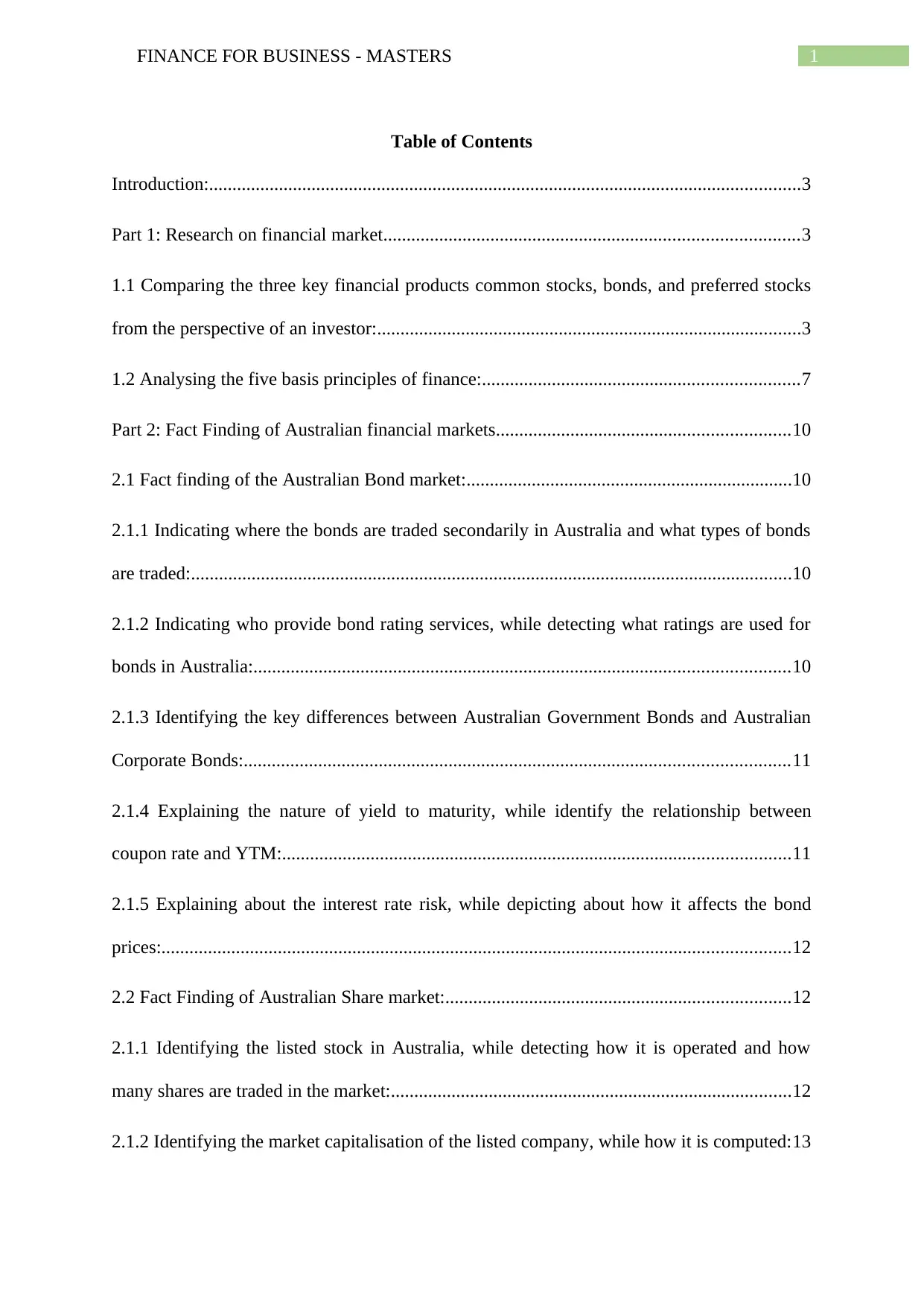
1FINANCE FOR BUSINESS - MASTERS
Table of Contents
Introduction:...............................................................................................................................3
Part 1: Research on financial market.........................................................................................3
1.1 Comparing the three key financial products common stocks, bonds, and preferred stocks
from the perspective of an investor:...........................................................................................3
1.2 Analysing the five basis principles of finance:....................................................................7
Part 2: Fact Finding of Australian financial markets...............................................................10
2.1 Fact finding of the Australian Bond market:......................................................................10
2.1.1 Indicating where the bonds are traded secondarily in Australia and what types of bonds
are traded:.................................................................................................................................10
2.1.2 Indicating who provide bond rating services, while detecting what ratings are used for
bonds in Australia:...................................................................................................................10
2.1.3 Identifying the key differences between Australian Government Bonds and Australian
Corporate Bonds:.....................................................................................................................11
2.1.4 Explaining the nature of yield to maturity, while identify the relationship between
coupon rate and YTM:.............................................................................................................11
2.1.5 Explaining about the interest rate risk, while depicting about how it affects the bond
prices:.......................................................................................................................................12
2.2 Fact Finding of Australian Share market:..........................................................................12
2.1.1 Identifying the listed stock in Australia, while detecting how it is operated and how
many shares are traded in the market:......................................................................................12
2.1.2 Identifying the market capitalisation of the listed company, while how it is computed:13
Table of Contents
Introduction:...............................................................................................................................3
Part 1: Research on financial market.........................................................................................3
1.1 Comparing the three key financial products common stocks, bonds, and preferred stocks
from the perspective of an investor:...........................................................................................3
1.2 Analysing the five basis principles of finance:....................................................................7
Part 2: Fact Finding of Australian financial markets...............................................................10
2.1 Fact finding of the Australian Bond market:......................................................................10
2.1.1 Indicating where the bonds are traded secondarily in Australia and what types of bonds
are traded:.................................................................................................................................10
2.1.2 Indicating who provide bond rating services, while detecting what ratings are used for
bonds in Australia:...................................................................................................................10
2.1.3 Identifying the key differences between Australian Government Bonds and Australian
Corporate Bonds:.....................................................................................................................11
2.1.4 Explaining the nature of yield to maturity, while identify the relationship between
coupon rate and YTM:.............................................................................................................11
2.1.5 Explaining about the interest rate risk, while depicting about how it affects the bond
prices:.......................................................................................................................................12
2.2 Fact Finding of Australian Share market:..........................................................................12
2.1.1 Identifying the listed stock in Australia, while detecting how it is operated and how
many shares are traded in the market:......................................................................................12
2.1.2 Identifying the market capitalisation of the listed company, while how it is computed:13

2FINANCE FOR BUSINESS - MASTERS
2.1.3 Identifying the oldest share index in Australia, while detecting how the index is
computed:.................................................................................................................................13
2.1.4 Presenting the 3-year historical movement of graph of the index:.................................14
2.1.5 Commenting on the trend, while identifying the factors that may explain the trend:.....14
Part 3: Risk analysis and project evaluation............................................................................15
3.1 Perform a sensitivity analysis:...........................................................................................15
3.2 Performing NPV break even analysis for the case:............................................................16
Conclusion:..............................................................................................................................17
References and Bibliography:..................................................................................................18
2.1.3 Identifying the oldest share index in Australia, while detecting how the index is
computed:.................................................................................................................................13
2.1.4 Presenting the 3-year historical movement of graph of the index:.................................14
2.1.5 Commenting on the trend, while identifying the factors that may explain the trend:.....14
Part 3: Risk analysis and project evaluation............................................................................15
3.1 Perform a sensitivity analysis:...........................................................................................15
3.2 Performing NPV break even analysis for the case:............................................................16
Conclusion:..............................................................................................................................17
References and Bibliography:..................................................................................................18
⊘ This is a preview!⊘
Do you want full access?
Subscribe today to unlock all pages.

Trusted by 1+ million students worldwide
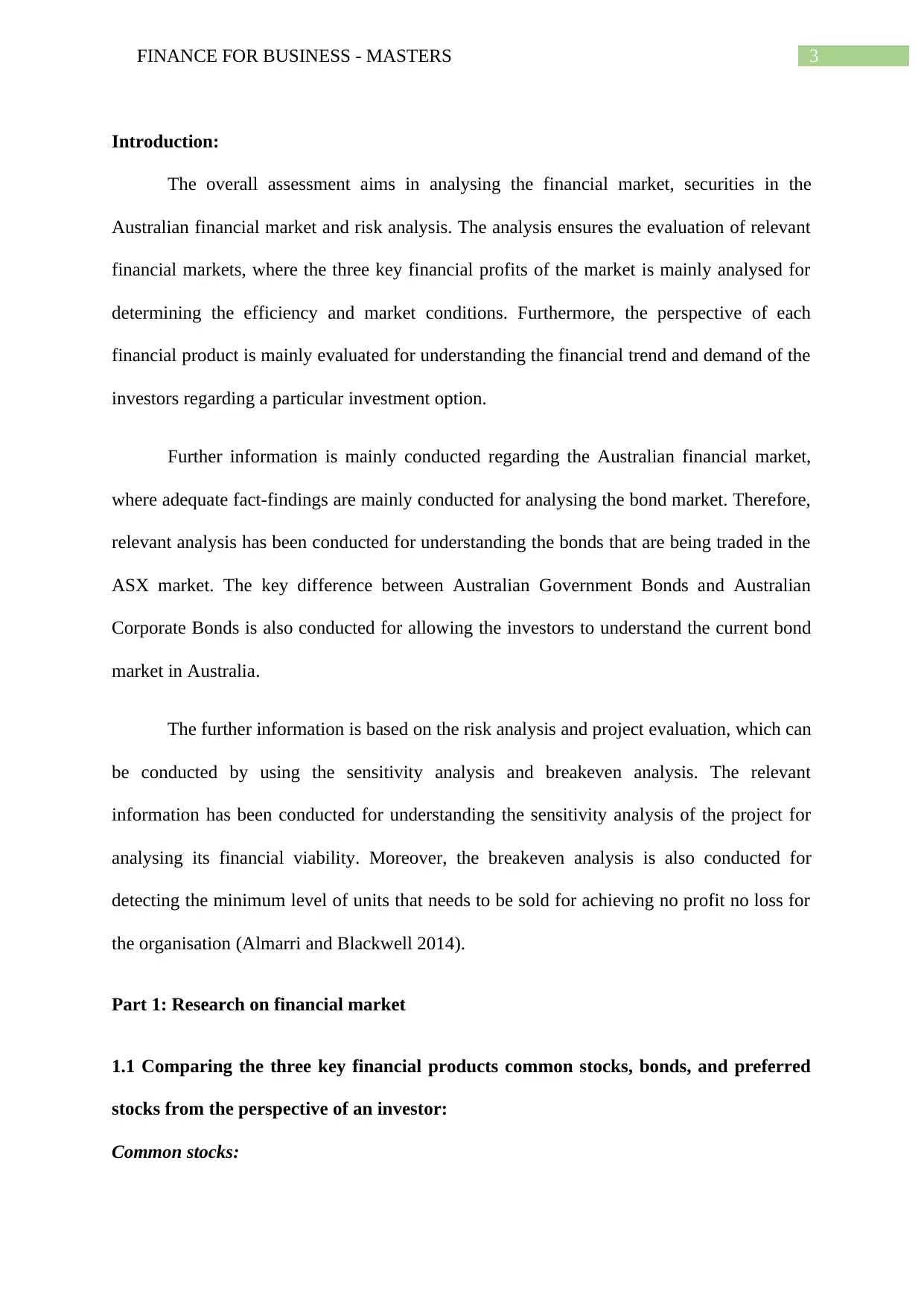
3FINANCE FOR BUSINESS - MASTERS
Introduction:
The overall assessment aims in analysing the financial market, securities in the
Australian financial market and risk analysis. The analysis ensures the evaluation of relevant
financial markets, where the three key financial profits of the market is mainly analysed for
determining the efficiency and market conditions. Furthermore, the perspective of each
financial product is mainly evaluated for understanding the financial trend and demand of the
investors regarding a particular investment option.
Further information is mainly conducted regarding the Australian financial market,
where adequate fact-findings are mainly conducted for analysing the bond market. Therefore,
relevant analysis has been conducted for understanding the bonds that are being traded in the
ASX market. The key difference between Australian Government Bonds and Australian
Corporate Bonds is also conducted for allowing the investors to understand the current bond
market in Australia.
The further information is based on the risk analysis and project evaluation, which can
be conducted by using the sensitivity analysis and breakeven analysis. The relevant
information has been conducted for understanding the sensitivity analysis of the project for
analysing its financial viability. Moreover, the breakeven analysis is also conducted for
detecting the minimum level of units that needs to be sold for achieving no profit no loss for
the organisation (Almarri and Blackwell 2014).
Part 1: Research on financial market
1.1 Comparing the three key financial products common stocks, bonds, and preferred
stocks from the perspective of an investor:
Common stocks:
Introduction:
The overall assessment aims in analysing the financial market, securities in the
Australian financial market and risk analysis. The analysis ensures the evaluation of relevant
financial markets, where the three key financial profits of the market is mainly analysed for
determining the efficiency and market conditions. Furthermore, the perspective of each
financial product is mainly evaluated for understanding the financial trend and demand of the
investors regarding a particular investment option.
Further information is mainly conducted regarding the Australian financial market,
where adequate fact-findings are mainly conducted for analysing the bond market. Therefore,
relevant analysis has been conducted for understanding the bonds that are being traded in the
ASX market. The key difference between Australian Government Bonds and Australian
Corporate Bonds is also conducted for allowing the investors to understand the current bond
market in Australia.
The further information is based on the risk analysis and project evaluation, which can
be conducted by using the sensitivity analysis and breakeven analysis. The relevant
information has been conducted for understanding the sensitivity analysis of the project for
analysing its financial viability. Moreover, the breakeven analysis is also conducted for
detecting the minimum level of units that needs to be sold for achieving no profit no loss for
the organisation (Almarri and Blackwell 2014).
Part 1: Research on financial market
1.1 Comparing the three key financial products common stocks, bonds, and preferred
stocks from the perspective of an investor:
Common stocks:
Paraphrase This Document
Need a fresh take? Get an instant paraphrase of this document with our AI Paraphraser

4FINANCE FOR BUSINESS - MASTERS
Comparison Common Stock
Ownership status Full
Nature of funding Equity
Risks High
Income Dividends
Voting right Full
Maturity No
Priority in liquidation Last
The information in the above table states about the overall significance of the
financial products, which can be used by the investors to improve their exposure in the capital
market. The common stock is the basic form of investment, where the investors are able to
get the appropriate ownership of the organization after purchase. There is high level of risk
involved in the investment, as the company’s share price value is subject to the fluctuations in
the capital market. The stock Appen Ltd has been used as an example, which states about the
current market prices of the company, which has increased from 0.50 to 22.98 from the initial
offering price. Hence, the company’s performance has improved exponentially over the
period of time (Finance.yahoo.com 2019).
Appen Ltd Common Stock
First issuance 7-Jan-2015
Offer price $0.50 per share
Shares offered 30.0 million
Raised capital $15.0 million
Trading market ASX
Trading volume 924,763
Market
capitalization
2.8 Billion
Comparison Common Stock
Ownership status Full
Nature of funding Equity
Risks High
Income Dividends
Voting right Full
Maturity No
Priority in liquidation Last
The information in the above table states about the overall significance of the
financial products, which can be used by the investors to improve their exposure in the capital
market. The common stock is the basic form of investment, where the investors are able to
get the appropriate ownership of the organization after purchase. There is high level of risk
involved in the investment, as the company’s share price value is subject to the fluctuations in
the capital market. The stock Appen Ltd has been used as an example, which states about the
current market prices of the company, which has increased from 0.50 to 22.98 from the initial
offering price. Hence, the company’s performance has improved exponentially over the
period of time (Finance.yahoo.com 2019).
Appen Ltd Common Stock
First issuance 7-Jan-2015
Offer price $0.50 per share
Shares offered 30.0 million
Raised capital $15.0 million
Trading market ASX
Trading volume 924,763
Market
capitalization
2.8 Billion
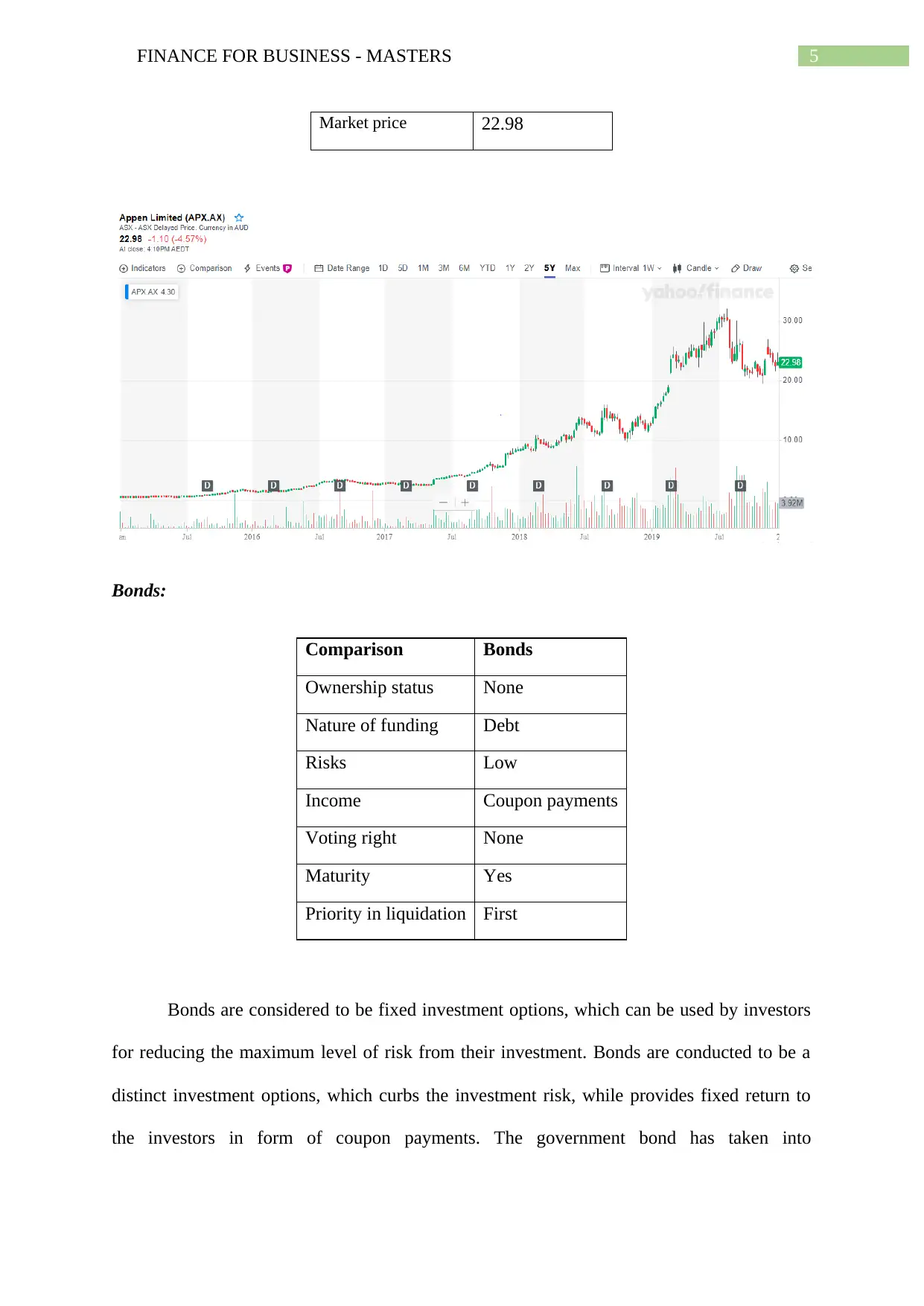
5FINANCE FOR BUSINESS - MASTERS
Market price 22.98
Bonds:
Comparison Bonds
Ownership status None
Nature of funding Debt
Risks Low
Income Coupon payments
Voting right None
Maturity Yes
Priority in liquidation First
Bonds are considered to be fixed investment options, which can be used by investors
for reducing the maximum level of risk from their investment. Bonds are conducted to be a
distinct investment options, which curbs the investment risk, while provides fixed return to
the investors in form of coupon payments. The government bond has taken into
Market price 22.98
Bonds:
Comparison Bonds
Ownership status None
Nature of funding Debt
Risks Low
Income Coupon payments
Voting right None
Maturity Yes
Priority in liquidation First
Bonds are considered to be fixed investment options, which can be used by investors
for reducing the maximum level of risk from their investment. Bonds are conducted to be a
distinct investment options, which curbs the investment risk, while provides fixed return to
the investors in form of coupon payments. The government bond has taken into
⊘ This is a preview!⊘
Do you want full access?
Subscribe today to unlock all pages.

Trusted by 1+ million students worldwide

6FINANCE FOR BUSINESS - MASTERS
consideration, where total market capitalization of the overall bonds is at the level of
4,075.52 million (Asx.com.au 2018).
Australian Government Treasury Bonds
GSBK39
Bonds
First issuance 20-Oct-2015
Offer price 100
Trading market ASX
Trading volume 3626
Market capitalization 4,075.52 Million
Coupon rate 3.25%
Payment frequency Semi annually
Market price 101.89
Preferred stocks:
Comparison Preferred stocks
Ownership status None
Nature of funding Debt
Risks Medium
Income Fixed dividends
Voting right None
Maturity Yes
Priority in liquidation After Bonds before Common Stock
The companies mainly publish the preferred stock or the Capital notes in form of a
security to the investors, which require certain fixed returns in form of interest payment.
There are different forms of preference shares, where some are convertible and other only
consideration, where total market capitalization of the overall bonds is at the level of
4,075.52 million (Asx.com.au 2018).
Australian Government Treasury Bonds
GSBK39
Bonds
First issuance 20-Oct-2015
Offer price 100
Trading market ASX
Trading volume 3626
Market capitalization 4,075.52 Million
Coupon rate 3.25%
Payment frequency Semi annually
Market price 101.89
Preferred stocks:
Comparison Preferred stocks
Ownership status None
Nature of funding Debt
Risks Medium
Income Fixed dividends
Voting right None
Maturity Yes
Priority in liquidation After Bonds before Common Stock
The companies mainly publish the preferred stock or the Capital notes in form of a
security to the investors, which require certain fixed returns in form of interest payment.
There are different forms of preference shares, where some are convertible and other only
Paraphrase This Document
Need a fresh take? Get an instant paraphrase of this document with our AI Paraphraser

7FINANCE FOR BUSINESS - MASTERS
pay significant interest to the investors who are willing to pay appropriate capital for a
particular share. The preference share of AMPPA is taken into consideration, where the stock
yields a return of 4.10%, while the market price of the investment is at the level of 104.23
(Asx.com.au 2013).
AMPPA Preferred stocks
First issuance 01-Oct-2016
Offer price 100
Trading market ASX
Trading volume 2500
Yield 4.10%
Market price 104.23
1.2 Analysing the five basis principles of finance:
The five basic principles of finance are depicted as follows.
Cash Flow Is What Matters:
Cash flow valuation is mandatory, as it allows investor to understanding the actual
market capitalisation of the company, while viewing their worth during IPO. The relevant
pay significant interest to the investors who are willing to pay appropriate capital for a
particular share. The preference share of AMPPA is taken into consideration, where the stock
yields a return of 4.10%, while the market price of the investment is at the level of 104.23
(Asx.com.au 2013).
AMPPA Preferred stocks
First issuance 01-Oct-2016
Offer price 100
Trading market ASX
Trading volume 2500
Yield 4.10%
Market price 104.23
1.2 Analysing the five basis principles of finance:
The five basic principles of finance are depicted as follows.
Cash Flow Is What Matters:
Cash flow valuation is mandatory, as it allows investor to understanding the actual
market capitalisation of the company, while viewing their worth during IPO. The relevant

8FINANCE FOR BUSINESS - MASTERS
news https://www.cnbc.com/2019/05/12/life360-went-public-on-the-australian-securities-
exchange.html, indicates about the valuation process that was conducted on the Social Media
Company Life360 before the initial of the IPO. This valuation process was mainly possible
by using the cash flow valuation method, as it allowed the investors to correctly value the
company current valuation and complete the IPO process (Rodriguez 2019). The calculation
of DCF valuation and FCFEE approach mainly requires cash valuation, which can be used
for generating high level of income from investment.
Money Has a Time Value:
Money has a time value, where investors are keen on understanding the values of such
investment and make relevant investment decisions. The current operations of CSL Limited
are relevantly high in comparison to CBA, as seen in the new
https://au.finance.yahoo.com/news/csl-closing-cba-asx-biggest-040614773.html. Therefore,
the current valuation and progress of the company is taken into considerations before
anticipating future income, hence the current financial strength of CSL is relevantly higher,
which is why the companies share have increased more than 50% in the current year alone in
comparison to CBA. Thus, the news indicates that the investors are relying on the current
valuation of the organisation (Au.finance.yahoo.com 2019).
Risk Requires a Reward:
The information in news https://au.finance.yahoo.com/news/3-asx-options-low-risk-
014517684.html, mainly indicates about the risk reward conditions of an organization. From
the analysis of the news, it is detected that companies like Harvey Norman Ltd mainly allow
the investors to each higher dividend, as their risk contribution is greater. On the other hand,
the safest investment option is considered to be REITs and low-risk investment option, which
could directly reduce the level of investment options (Au.finance.yahoo.com 2019). Hence,
news https://www.cnbc.com/2019/05/12/life360-went-public-on-the-australian-securities-
exchange.html, indicates about the valuation process that was conducted on the Social Media
Company Life360 before the initial of the IPO. This valuation process was mainly possible
by using the cash flow valuation method, as it allowed the investors to correctly value the
company current valuation and complete the IPO process (Rodriguez 2019). The calculation
of DCF valuation and FCFEE approach mainly requires cash valuation, which can be used
for generating high level of income from investment.
Money Has a Time Value:
Money has a time value, where investors are keen on understanding the values of such
investment and make relevant investment decisions. The current operations of CSL Limited
are relevantly high in comparison to CBA, as seen in the new
https://au.finance.yahoo.com/news/csl-closing-cba-asx-biggest-040614773.html. Therefore,
the current valuation and progress of the company is taken into considerations before
anticipating future income, hence the current financial strength of CSL is relevantly higher,
which is why the companies share have increased more than 50% in the current year alone in
comparison to CBA. Thus, the news indicates that the investors are relying on the current
valuation of the organisation (Au.finance.yahoo.com 2019).
Risk Requires a Reward:
The information in news https://au.finance.yahoo.com/news/3-asx-options-low-risk-
014517684.html, mainly indicates about the risk reward conditions of an organization. From
the analysis of the news, it is detected that companies like Harvey Norman Ltd mainly allow
the investors to each higher dividend, as their risk contribution is greater. On the other hand,
the safest investment option is considered to be REITs and low-risk investment option, which
could directly reduce the level of investment options (Au.finance.yahoo.com 2019). Hence,
⊘ This is a preview!⊘
Do you want full access?
Subscribe today to unlock all pages.

Trusted by 1+ million students worldwide
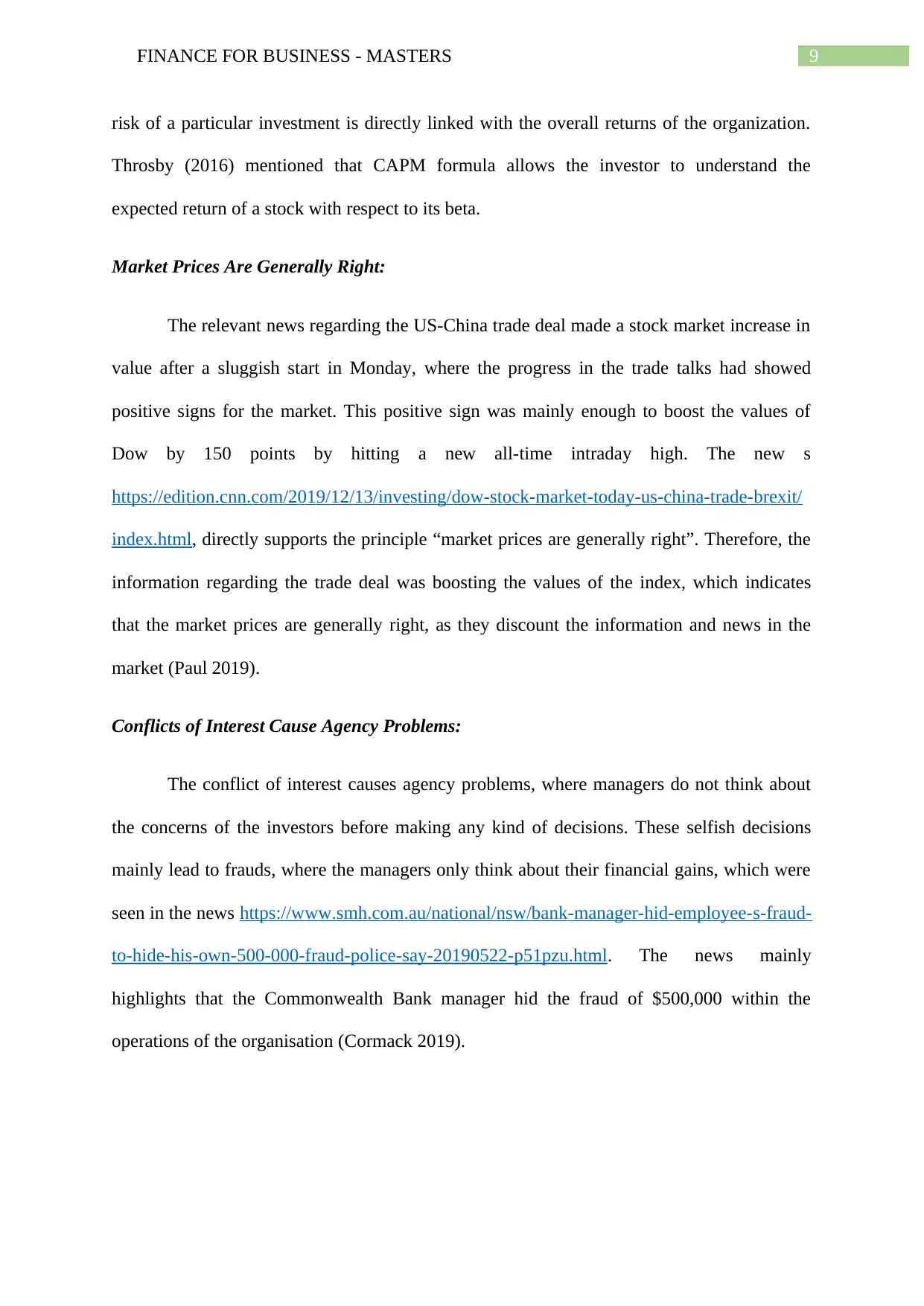
9FINANCE FOR BUSINESS - MASTERS
risk of a particular investment is directly linked with the overall returns of the organization.
Throsby (2016) mentioned that CAPM formula allows the investor to understand the
expected return of a stock with respect to its beta.
Market Prices Are Generally Right:
The relevant news regarding the US-China trade deal made a stock market increase in
value after a sluggish start in Monday, where the progress in the trade talks had showed
positive signs for the market. This positive sign was mainly enough to boost the values of
Dow by 150 points by hitting a new all-time intraday high. The new s
https://edition.cnn.com/2019/12/13/investing/dow-stock-market-today-us-china-trade-brexit/
index.html, directly supports the principle “market prices are generally right”. Therefore, the
information regarding the trade deal was boosting the values of the index, which indicates
that the market prices are generally right, as they discount the information and news in the
market (Paul 2019).
Conflicts of Interest Cause Agency Problems:
The conflict of interest causes agency problems, where managers do not think about
the concerns of the investors before making any kind of decisions. These selfish decisions
mainly lead to frauds, where the managers only think about their financial gains, which were
seen in the news https://www.smh.com.au/national/nsw/bank-manager-hid-employee-s-fraud-
to-hide-his-own-500-000-fraud-police-say-20190522-p51pzu.html. The news mainly
highlights that the Commonwealth Bank manager hid the fraud of $500,000 within the
operations of the organisation (Cormack 2019).
risk of a particular investment is directly linked with the overall returns of the organization.
Throsby (2016) mentioned that CAPM formula allows the investor to understand the
expected return of a stock with respect to its beta.
Market Prices Are Generally Right:
The relevant news regarding the US-China trade deal made a stock market increase in
value after a sluggish start in Monday, where the progress in the trade talks had showed
positive signs for the market. This positive sign was mainly enough to boost the values of
Dow by 150 points by hitting a new all-time intraday high. The new s
https://edition.cnn.com/2019/12/13/investing/dow-stock-market-today-us-china-trade-brexit/
index.html, directly supports the principle “market prices are generally right”. Therefore, the
information regarding the trade deal was boosting the values of the index, which indicates
that the market prices are generally right, as they discount the information and news in the
market (Paul 2019).
Conflicts of Interest Cause Agency Problems:
The conflict of interest causes agency problems, where managers do not think about
the concerns of the investors before making any kind of decisions. These selfish decisions
mainly lead to frauds, where the managers only think about their financial gains, which were
seen in the news https://www.smh.com.au/national/nsw/bank-manager-hid-employee-s-fraud-
to-hide-his-own-500-000-fraud-police-say-20190522-p51pzu.html. The news mainly
highlights that the Commonwealth Bank manager hid the fraud of $500,000 within the
operations of the organisation (Cormack 2019).
Paraphrase This Document
Need a fresh take? Get an instant paraphrase of this document with our AI Paraphraser
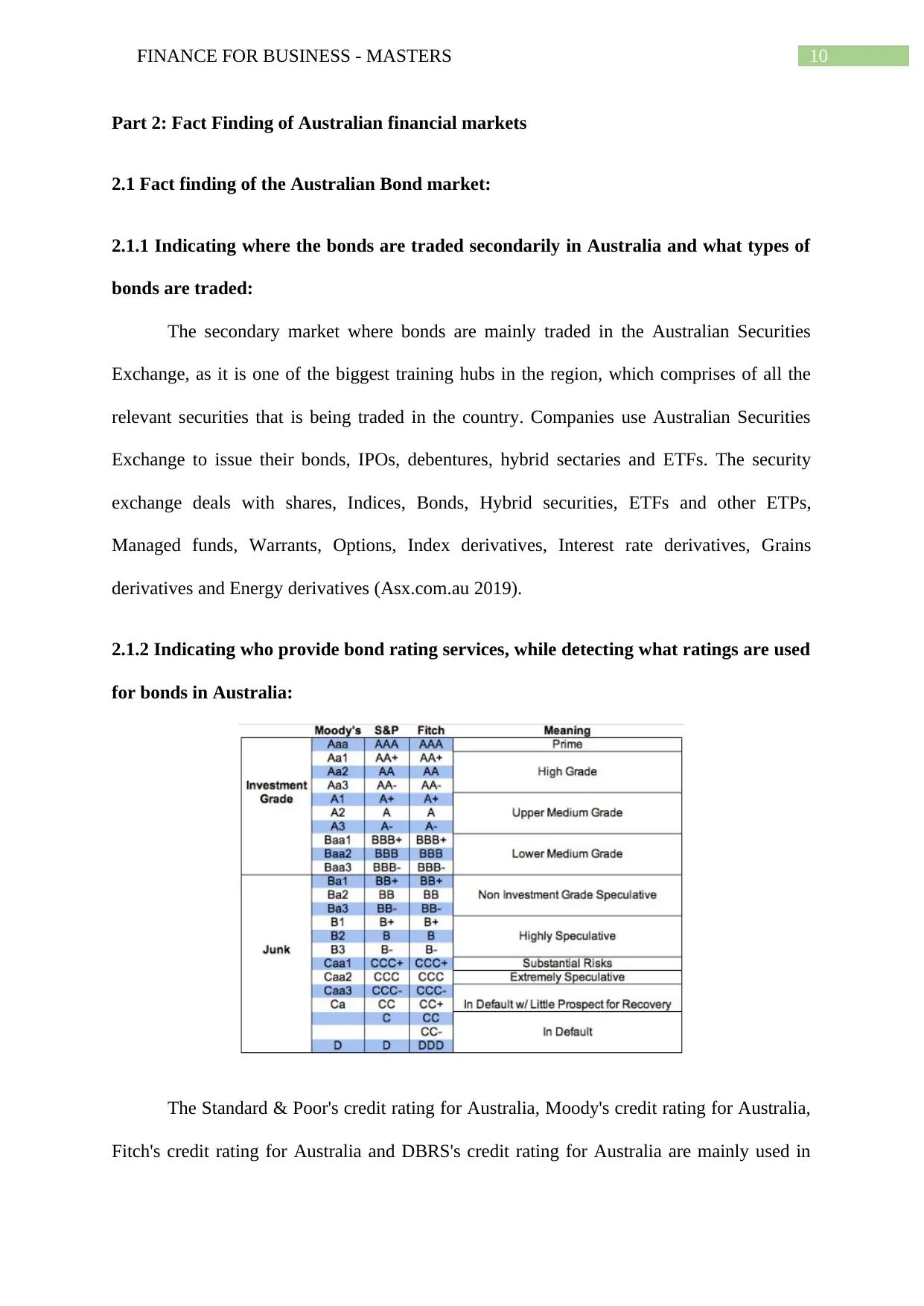
10FINANCE FOR BUSINESS - MASTERS
Part 2: Fact Finding of Australian financial markets
2.1 Fact finding of the Australian Bond market:
2.1.1 Indicating where the bonds are traded secondarily in Australia and what types of
bonds are traded:
The secondary market where bonds are mainly traded in the Australian Securities
Exchange, as it is one of the biggest training hubs in the region, which comprises of all the
relevant securities that is being traded in the country. Companies use Australian Securities
Exchange to issue their bonds, IPOs, debentures, hybrid sectaries and ETFs. The security
exchange deals with shares, Indices, Bonds, Hybrid securities, ETFs and other ETPs,
Managed funds, Warrants, Options, Index derivatives, Interest rate derivatives, Grains
derivatives and Energy derivatives (Asx.com.au 2019).
2.1.2 Indicating who provide bond rating services, while detecting what ratings are used
for bonds in Australia:
The Standard & Poor's credit rating for Australia, Moody's credit rating for Australia,
Fitch's credit rating for Australia and DBRS's credit rating for Australia are mainly used in
Part 2: Fact Finding of Australian financial markets
2.1 Fact finding of the Australian Bond market:
2.1.1 Indicating where the bonds are traded secondarily in Australia and what types of
bonds are traded:
The secondary market where bonds are mainly traded in the Australian Securities
Exchange, as it is one of the biggest training hubs in the region, which comprises of all the
relevant securities that is being traded in the country. Companies use Australian Securities
Exchange to issue their bonds, IPOs, debentures, hybrid sectaries and ETFs. The security
exchange deals with shares, Indices, Bonds, Hybrid securities, ETFs and other ETPs,
Managed funds, Warrants, Options, Index derivatives, Interest rate derivatives, Grains
derivatives and Energy derivatives (Asx.com.au 2019).
2.1.2 Indicating who provide bond rating services, while detecting what ratings are used
for bonds in Australia:
The Standard & Poor's credit rating for Australia, Moody's credit rating for Australia,
Fitch's credit rating for Australia and DBRS's credit rating for Australia are mainly used in
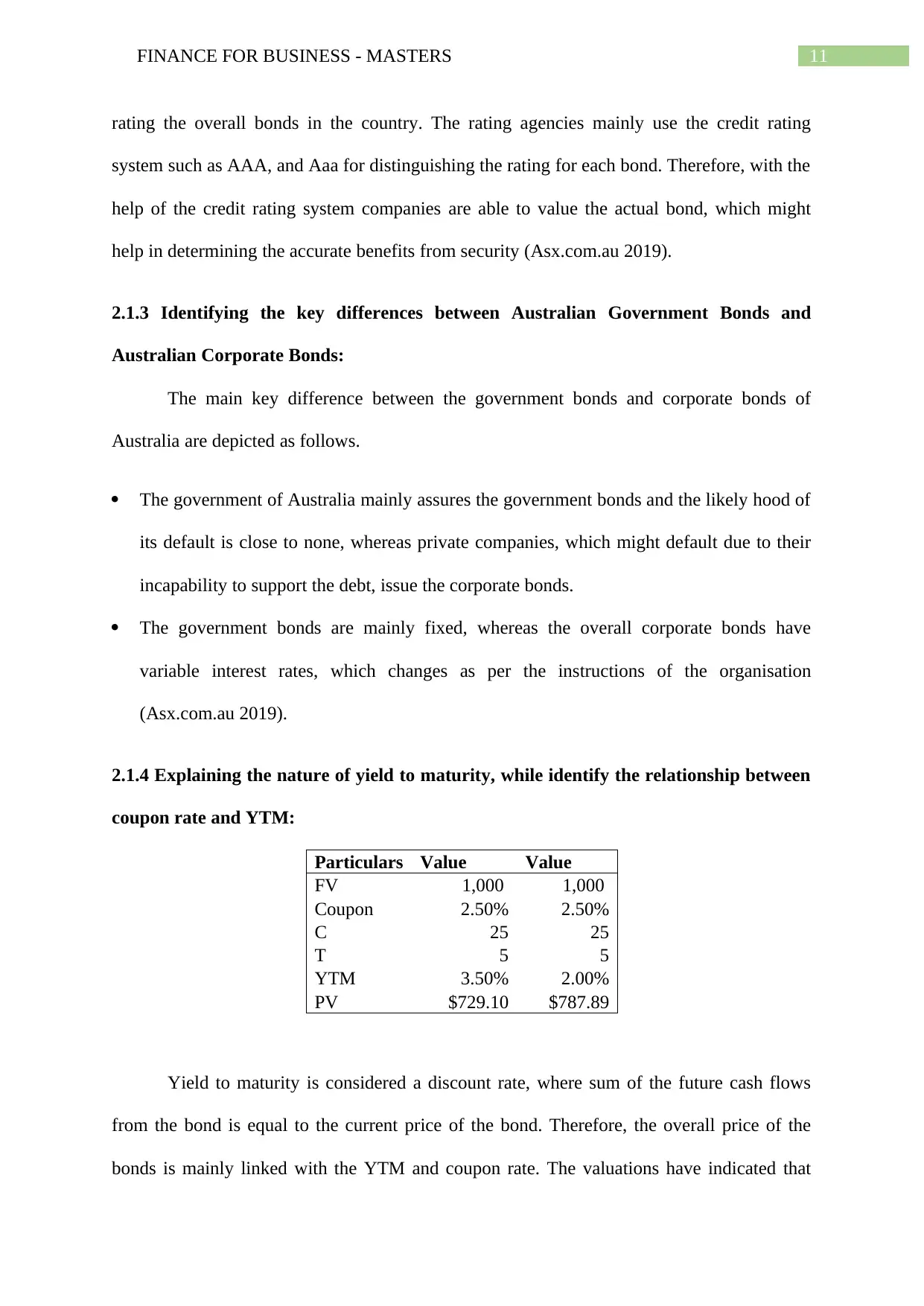
11FINANCE FOR BUSINESS - MASTERS
rating the overall bonds in the country. The rating agencies mainly use the credit rating
system such as AAA, and Aaa for distinguishing the rating for each bond. Therefore, with the
help of the credit rating system companies are able to value the actual bond, which might
help in determining the accurate benefits from security (Asx.com.au 2019).
2.1.3 Identifying the key differences between Australian Government Bonds and
Australian Corporate Bonds:
The main key difference between the government bonds and corporate bonds of
Australia are depicted as follows.
The government of Australia mainly assures the government bonds and the likely hood of
its default is close to none, whereas private companies, which might default due to their
incapability to support the debt, issue the corporate bonds.
The government bonds are mainly fixed, whereas the overall corporate bonds have
variable interest rates, which changes as per the instructions of the organisation
(Asx.com.au 2019).
2.1.4 Explaining the nature of yield to maturity, while identify the relationship between
coupon rate and YTM:
Particulars Value Value
FV 1,000 1,000
Coupon 2.50% 2.50%
C 25 25
T 5 5
YTM 3.50% 2.00%
PV $729.10 $787.89
Yield to maturity is considered a discount rate, where sum of the future cash flows
from the bond is equal to the current price of the bond. Therefore, the overall price of the
bonds is mainly linked with the YTM and coupon rate. The valuations have indicated that
rating the overall bonds in the country. The rating agencies mainly use the credit rating
system such as AAA, and Aaa for distinguishing the rating for each bond. Therefore, with the
help of the credit rating system companies are able to value the actual bond, which might
help in determining the accurate benefits from security (Asx.com.au 2019).
2.1.3 Identifying the key differences between Australian Government Bonds and
Australian Corporate Bonds:
The main key difference between the government bonds and corporate bonds of
Australia are depicted as follows.
The government of Australia mainly assures the government bonds and the likely hood of
its default is close to none, whereas private companies, which might default due to their
incapability to support the debt, issue the corporate bonds.
The government bonds are mainly fixed, whereas the overall corporate bonds have
variable interest rates, which changes as per the instructions of the organisation
(Asx.com.au 2019).
2.1.4 Explaining the nature of yield to maturity, while identify the relationship between
coupon rate and YTM:
Particulars Value Value
FV 1,000 1,000
Coupon 2.50% 2.50%
C 25 25
T 5 5
YTM 3.50% 2.00%
PV $729.10 $787.89
Yield to maturity is considered a discount rate, where sum of the future cash flows
from the bond is equal to the current price of the bond. Therefore, the overall price of the
bonds is mainly linked with the YTM and coupon rate. The valuations have indicated that
⊘ This is a preview!⊘
Do you want full access?
Subscribe today to unlock all pages.

Trusted by 1+ million students worldwide
1 out of 21
Related Documents
Your All-in-One AI-Powered Toolkit for Academic Success.
+13062052269
info@desklib.com
Available 24*7 on WhatsApp / Email
![[object Object]](/_next/static/media/star-bottom.7253800d.svg)
Unlock your academic potential
Copyright © 2020–2025 A2Z Services. All Rights Reserved. Developed and managed by ZUCOL.





